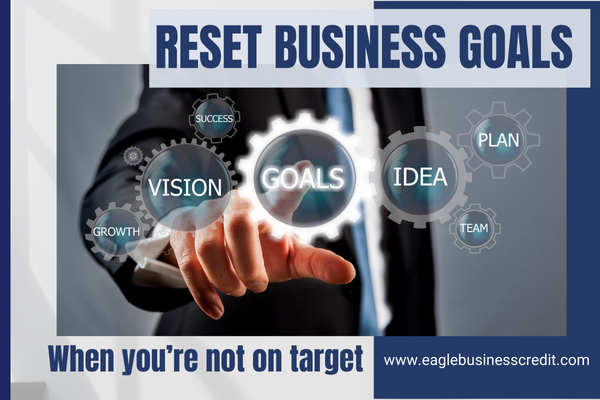Running a small business is a dynamic endeavor that often requires adjusting to changing economic landscapes. When the economy isn’t performing as well as anticipated and interest rates remain high, it can be even more challenging to meet the financial goals set at the beginning of the year. If you find your business off-target, you should review and reset your goals now to align with the current climate. Here’s a step-by-step guide on how to reassess and redefine your business objectives effectively.
1. Conduct a Thorough Business Review
Assess Actual Financial Performance: Begin by analyzing your financial statements to understand your current financial health. Review your profit and loss statement, balance sheet, and cash flow statement. Identify areas where performance has deviated from your initial forecasts and assess what changes could be made to correct the deficit.
Evaluate Key Performance Indicators (KPIs): Examine the KPIs you set at the beginning of the year. Determine which ones are lagging and why. This will provide insight into specific areas that need attention.
Customer and Market Analysis: Understand how the economic climate has impacted your customers. Conduct surveys or reach out for feedback to gauge their current needs and preferences. Analyze market trends to identify shifts that could affect your business.
2. Identify the Root Causes
Economic Factors: Acknowledge which external economic factors have affected your business, such as high-interest rates, inflation and lower consumer spending. Understanding these influences can help you make informed decisions.
Internal Issues: Assess internal factors such as operational inefficiencies, marketing strategies, and employee performance. Sometimes, internal challenges can be as significant as external ones in affecting your business performance.
3. Reset Financial Goals
Revised Revenue Targets: Based on your financial review, set more realistic revenue targets. Consider how much higher interest rates and inflation have affected your business margins and adjust your expectations accordingly. It’s important to be ambitious yet attainable.
Cost Management: Look for areas where you can reduce expenses without compromising the quality of your products or services. This might involve renegotiating contracts, finding alternative suppliers, or cutting non-essential costs.
Cash Flow Forecasting: Create a revised cash flow forecast to ensure you can meet your financial obligations. This will help you plan for potential shortfalls and make necessary adjustments proactively. Do you need to consider a new or additional funding lines that will be able to support your ongoing cash flow needs?
4. Adapt Your Marketing Strategy
Refocus Your Target Audience: If your current customer base is spending less, consider expanding your target audience. Identify new market segments that may be more resilient to economic fluctuations.
Cost-Effective Marketing Tactics: Shift to more cost-effective marketing strategies. Utilize social media, email marketing, and content marketing to reach your audience without incurring high costs. Leverage SEO to improve organic traffic to your website.
Promotions and Discounts: Offer promotions or discounts to stimulate demand. However, ensure that these incentives do not erode your profit margins excessively.
5. Innovate Your Product or Service Offerings
Diversification: Consider diversifying your product or service offerings to cater to new customer needs. This could involve adding new products, offering bundled services, or creating value-added features.
Quality Improvement: Focus on improving the quality of your existing offerings. High-quality products and services can help retain customers and justify premium pricing.
Feedback Loop: Establish a continuous feedback loop with your customers to understand their evolving needs and preferences. Use this feedback to drive innovation and stay relevant.
6. Strengthen Your Team
Employee Training: Invest in training programs to enhance your team’s skills and productivity. A well-trained team can adapt more easily to changes and contribute to achieving revised goals.
Employee Engagement: Boost employee morale and engagement through recognition programs and open communication. Engaged employees are more likely to go the extra mile to help the business succeed.

Right-sizing: Evaluate your staffing levels to ensure they align with your current business needs. This might involve hiring additional staff in critical areas or making the tough decision to downsize in others.
7. Leverage Technology
Automation: Implement automation tools to streamline operations and reduce costs. Automation can improve efficiency in areas such as inventory management, customer service, and marketing.
Data Analytics: Utilize data analytics to gain insights into customer behavior, market trends, and operational performance. Data-driven decisions can enhance your strategic planning and execution.
Digital Transformation: Embrace digital transformation to stay competitive. This could involve developing an e-commerce platform, enhancing your online presence, or utilizing cloud-based solutions for better scalability.
8. Enhance Customer Relationships
Customer Loyalty Programs: Develop loyalty programs to reward repeat customers. This can increase customer retention and encourage higher spending.
Personalized Communication: Use personalized communication to build stronger relationships with your customers. Tailored messages and offers can increase engagement and sales.
Exceptional Service: Focus on providing exceptional customer service. Positive customer experiences can lead to word-of-mouth referrals and long-term loyalty.
9. Seek External Advice
Mentorship: Seek advice from mentors or industry experts. Their experience and insights can provide valuable perspectives on navigating challenging times.
Consultancy: Consider hiring business consultants for specific areas where you need expertise, such as financial planning, marketing strategy, or operational efficiency.
Peer Networks: Join business networks or industry associations to connect with other business owners. Sharing experiences and strategies can provide support and new ideas.
10. Monitor and Adjust Regularly
Frequent Reviews: Schedule regular reviews of your business plan and consider revising your goals and strategies. This allows you to track progress, make adjustments, and stay responsive to changing conditions.
Flexibility: Remain flexible and open to change. The ability to pivot quickly in response to new challenges or opportunities is crucial for long-term success.

Conclusion
Adjusting your business goals in response to economic challenges is not an admission of failure but a strategic move to ensure sustainability and growth. By conducting a thorough review, identifying root causes, resetting financial targets, adapting marketing strategies, innovating offerings, strengthening your team, leveraging technology, enhancing customer relationships, seeking external advice, and regularly monitoring progress, you can steer your business through tough times and emerge stronger. The key is to stay proactive, resilient, and adaptable, just as the most successful business owners do and ensure your working capital can generate enough cash flow to meet your business expenses at all times.

